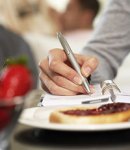 See Rob Rees’s comments below on the food diaries of local celebs and members of our media team.
See Rob Rees’s comments below on the food diaries of local celebs and members of our media team.
Here at Vision we understand that all the good intentions of those New Year resolutions are long gone, but with spring now just around the corner you may have renewed your promise to yourself to eat more healthily and get in shape for the summer.
Where do you start though? Perhaps you have dug out your gym membership card or have decided to start walking to work rather than take the bus? Whatever you might be doing, when it comes to diet we know here at VISION that many are left confused by health messages. Our March blog is all about helping you to sort through the jargon.
Picture this, it’s lunchtime you have decided to treat yourself to a coffee at your favourite coffee bar, you deserve it and it sounds like a great excuse to escape from work for an hour. You go for your usual, it’s been a hard week so you choose a large rather than a small. Then you are asked if you wish to order anything else which is great timing as a breakfast panini caught your eye only a few moments earlier on the way in as did rather appealing slab of chocolate biscuit cake and before you know, it’s a done deal!
So what I hear you say is what’s wrong with all this? Will the food police be after you? Well absolutely not! Our message to you is that the key to a healthy balanced diet is not to ban any foods but to balance what you eat by consuming a variety of foods from each food group as illustrated in the Food Standards Agency Eatwell plate as below:
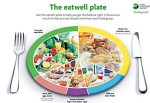
Food Standards Agency Eatwell Plate
So percentage wise we all should be aiming for:
(30% )Bread, Rice, Potato, Pasta
(12%) Meat, fish, eggs, beans
(30%) Fruit and vegetables
(15%) Milk and dairy
(7%) Food and drinks high in fat and/or sugar
Most of us now know that a healthy diet can improve our chances of leading a healthy life, however with many only knowing the basics and with manufacturers finding new and interesting ways of describing foods it can all get very confusing. For instance, breakfast cereal packs are sometimes decorated with encouraging nutritional claims but it’s not until you study the pack that you see a very high sugar content. Also, whilst many of us now know that adults should eat five portions of fruit and vegetables everyday, many do not know what a portion is.
We will be posting some useful tips throughout the month and would love to hear your thoughts on all this, but for now keep blogging and all the best from everyone here at VISION!
Our Celebrities
This month we have approached some high profile local public figures who have agreed to give us a breakdown of what they have been eating for breakfast, lunch and dinner over the course of a three day period. They have promised to tell the truth! The menu choices for the three days will then be sent to Liz Moran, our Public Analyst who will assess the selections and make comments. Rob Rees, our resident debate champion and of course ‘Cotswold Chef’ will offer up some suggestions to spice up our volunteers menus. By doing this we should all be able to pick up some useful information and share ideas.

Celeb No.1
Pete Bungard, Chief Exec, Gloucestershire County Council
Subject dimensions: 5’ 8” – 90kg – ‘obese’ according to chart on GP’s wall!
Date: 3 March 2009
Wake up in London – after attending construction industry recession debate
0630 – orange juice
Cycle to Paddington
0740 – doppio espresso and almond biscotti at Neros
0800 – fruit on train: bananas; grapes; orange+raspberry juice
0830 – cup of train tea
1000 – black Earl Grey
1215 – lunch at desk: left-over fruit from breakfast purchase = banana; apple; “super berry smoothie”
1400 – white coffee at meeting
1715 – white tea at meeting
Cycle home in downpour
1800 – Burrito: cheese, salsa, lettuce, tomato, mayo. Can of diet ginger beer
1900 – salad: mixed leaves, tomatoes, spring onion, various cheeses, Caesar dressing, 3x toast (no spread)
More cycling – total for today = 15 miles (ribs still hurt from falling off 2 weeks ago!)
2100 – chocolate nuts and raisins (quite a few). Another can of diet ginger beer.
A no-booze day!
————————————————————-
Date: 4 March 2009
Wake up at home ……
0700 – banana, orange juice and doppio espresso (I do love that Nespresso machine!)
1000 – white tea in meeting
1100 – blueberry muffin – gift from work colleague – not sure whose birthday I’ve missed!
1230 – lunch: goats cheese, walnut and beetroot salad. Sparkling water to drink
1500 – white tea
1700 – two apples
1800 – tortellini proscuitto (ham filling), fresh tomatoes, garlic bread. Diet ginger beer to drink
1830 – small bar of Cadbury Dairy Milk chocolate
2000 – chips from chip shop on way back from daughter’s clothes shopping. Diet ginger beer to drink
Cycle 11 miles
2115 – pint of Young’s beer
2210 – one apple
————————————————————-
Date: 5 March 2009
Wake up at home ……
0630 – orange juice
0800 – white tea
0900 – Conference event – banana, white tea, black coffee, small pastry
1230 – lunch: cheese tartlet; cheese filled potato skin; raw vegetables; veggie wrap; orange juice; nibble of stilton cheese; grapes
1600 – Doppio espresso
1800 – 100g packet of M&S chocolate brazils
1830 – orange juice, olives, grapes
2000 – Curry! 2 poppadams, mango chutney, 2 onion bhajis, vegetable korma, pilau rice, peshwari naan, chocolate pudding and cream. 2 glasses of wine
Cycle – 15 miles
2300 – Grapes
————————————————————-
Subject Bungard. P. hereby certifies 3 day blog complete and honest!
So, how will Pete’s food diary measure up with our Public Analyst & Rob Rees?
Liz Moran, Public Analyst, says…
Peter certainly has a varied diet and is certainly managing to eat his 5 a day of fruit and vegetables. He’s not eating much of a breakfast though, which may be why he feels the need for muffins and pastries mid-morning. He obviously has a bit of a sweet tooth, though he’s being very good in sticking to fruit to satisfy this most of the time. Fatty and salty foods don’t feature prominently in his diet though he may need to eat more starchy foods to give him the energy needed for his hectic lifestyle, and all the cycling!
Curry is very high in fat salt and calories, particularly when poppadums, rice and naan bread are thrown in too. You can get two days worth of your guideline daily amount of fat and salt in one hit. However, curry is a treat, so having one once in a while won’t do any harm.
And here’s what Rob Rees has to say…
Firstly I am not an expert in nutrition so won’t go into the details – just the top lines reference a balanced diet.
On quick glance it’s fair to say that Pete is eating a fairly good diet over these three days…then we dig a little deeper.
It seems that Pete has a bit of a grab and go lifestyle – although what he grabs is often fruit. He needs to make sure that a good healthy breakfast kick starts his day – before he goes cycling! To do it afterwards means he is already playing “catch up” on recharging the batteries. Fortified cereal with a topping of sliced banana and a glass of unsweetened fruit juice should do the trick. Pete has a demanding job but the lifestyle needs to make room for proper meal times and less on the hoof.
It is good to see that Pete bases a lot of his main meals on starchy items – pastas, pulses, beans, peas, lentils and rice should make up to 1/3 of our diet.
Pete doesn’t seem to have any fish in his diet – this is really essential as it has nutrients and vitamins that kill off the “free radicals”. Selenium in particular is essential for more mature men (sorry Pete) it is vital for protecting men again prostrate cancer. You can also get Selenium form nuts, meats and tomatoes.
The dairy items that Pete consumes over these three days are also extremely high in saturated fats (check out the new Food Standards Agency Campaign) – I would recommend perhaps reducing the amount that you eat – perhaps just a smaller portion or extra walnut and beetroot salad with the goats’ cheese.
Whilst he is getting his fruit levels you would question the amount of vegetables that Pete eats – he needs to do a bit more of what his mum and grandma would have told him and “eat his greens”. Pete is just about getting his 5 a day but could do better if he upped the veg levels. The green vegetables in particular are packed with nutrients and vitamins – iron in particular.
I’m ignoring chips – they do form part of a balanced diet as long as he doesn’t have them too often from a deep fryer and if the curry the next night was home cooked rather than from a take away or supermarket!
If you like to twitter visit me at www.twitter.com/thecotswoldchef
Rob Rees MBE is The Cotswold Chef™
————————————————————-
 Celeb No. 2
Celeb No. 2
Gloucestershire County Councillor, Will Windsor-Clive
Cabinet Member for Community Safety
Monday 9th March
Breakfast: 1 small tinned fruit + toast & marmalade
Lunch: Mushroom soup with white buttered baguette
Dinner: Cold beef, baked potato, beans in white sauce
Tuesday 10th March
Breakfast: 2 poached eggs on toast
Lunch: Sandwiches – one round ham & cheese + one round egg mayo
Dinner: Pasta shells with cheese on top
Wednesday 11th March
Breakfast: 2 poached eggs on toast
Lunch: Chicken & salad sandwich + asparagus wrapped in ham + mini chocolate eggs (3)
Dinner: Fish pie & broccoli
Liz says…
Hardly a piece of fruit or veg to be seen this week, though I guess race week is always going to be difficult in that respect. As Rob says, trying to eat your 5 a day is very important and is seen as one of the major ways that we can reduce the risk of developing cancer. Having fruit available in the workplace or on the go makes it easy to nibble on during the day whenever you get hungry. Muesli can be livened up no end with sliced banana or strawberries and you should always try to have at least two vegetables with your evening meal, preferably of different colours. Keep a bag of frozen peas handy for this.
Fibre is also missing from the diet and may result in a sluggish digestive system, particularly given that meat features regularly. Easy ways to increase fibre without having to chew your way through bowls of bran cereals is to have wholemeal bread, pasta and rice in place of refined. More fruit and veg in the diet will also increase fibre intake. Quite a lot of foods with a high salt content such as bacon, ham and cheese are being eaten. It’s not specified if the evening meals are homemade or ready meals. Ready meals contain high levels of salt which act as flavour enhancers to replace flavour that has been lost in processing. Having home-cooked meals and keeping bacon and cheese levels to a minimum will reduce salt intake. Mozzarella is a good low salt/low fat cheese option.
Rob says…
Well this is someone who is certainly doing well with their main meal of the day. A good balance here in terms of fish, meat and vegetables.
However it is also clear that this person likes to indulge in some of the less than healthy items in life e.g. chocolate, sticky cake, cream, treacle tarts, cheese etc. Perhaps a small reduction in this would go a long way. For this person it will be about the tiny changes that will add up in making them healthier rather than giving something up completely. For example using a little of a strong cheese in the cheese sauce rather a lot of a milder cheese – you can reduce the fat content this way but still get the taste.
I sense if this person had to put away the treats they would get quite down in the dumps and food should be about fun, not feeling guilty but being informed enough to make the right choices that suit your lifestyle.
Breakfast would be the perfect time for you to improve your diet – try cereals instead of the poached eggs and also a glass of fruit juice before leaving the house. Remember 5 a day is about juiced products as well as fresh, frozen, tinned and dried. Try grazing on some fruit, sultanas and nuts – these will give you loads of vitamins that well help fight the “free radicals”. I don’t see any fruit being consumed here which is quite appalling and will be doing your body a great deal of damage.
Rob Rees MBE is The Cotswold Chef™

Celeb No. 3
Citizen reporter, Emma Atkinson
Day 1:
Breakfast: Two pieces of white toast with butter + One glass of orange juice.
Lunch: No lunch as such as I didn’t get away from my desk! I did have a Satsuma and some ryvita crackers at about 4pm and a handful of biscuits. Many cups of fruit tea and honey throughout the day.
Dinner: Fresh ravioli pasta with olive oil and parmesan cheese and some brown bread. Also 2 more satsumas!
Day 2:
Breakfast: Two cups of fruit tea with honey + two pieces of toast with butter.
Two satsumas as a midmorning snack.
Lunch: Leek and potato soup with bread and butter.
Dinner: Salad with goats cheese and some crackers. Piece of fruit cake
Day 3:
Breakfast: Bacon sandwich (I got it for free when I was out on a job!) + cup of tea.
Lunch: M&S pasta with chicken, cranberry juice and some grapes
Dinner: Vegetable risotto + strawberry yogurt.
Liz says…
Breakfast is the opportunity to start as you mean to go on. Wholegrain cereals or wholemeal bread with fruit or juice will kick start your digestive system much better than white toast and will provide sustained energy throughout the course of the morning.
Skipping meals is always a bad idea. It’s very easy in our increasingly busy lives to not get around to having lunch, but it will reduce your energy and effectiveness for the rest of the day and leave you starving by dinner time. Take some sandwiches and fruit to work with you so you don’t need to go out to buy lunch, this will also save you lots of money. Try not to eat at your desk either, a few minutes away from the computer will aid your digestion and mentally refresh you!
Fruit teas are a good substitute for caffeinated drinks like tea and coffee and will stop you from becoming dehydrated and possibly developing high blood pressure. Very few people can survive the day without caffeine, so this is an excellent achievement.
Rob says…
This is looking like quite a good few days but it is clear that you are struggling to meet your 5 portions a day. It is important to do this as it will reduce your chances of diet related health conditions such as heart attack and cancer by nearly 20%.
The balance between the naughty stuff and the more wholesome stuff is good. The treat every now and again is perfect. It is though the balance that concerns me – even though the majority of foods consumed here are healthy. Satsuma overload perhaps? Try some other fruits that can fit into a pocket bag or sit in a bowl in the office. Every fruit contains different nutrients and vitamins and this complete combination adds up to the balanced diet.
Again I dont see any fish being consumed. This is a real problem here in Gloucestershire. We do need to increase the amount of fish especially oily fish in our diets if we want to stay fit and well. So for this one more balance please of the good stuff, definitely more vegetables and please have a go at some fish.
Media Team Food Diaries
 Dawn Birtles
Dawn Birtles
Marketing and Communications Manager
Gloucestershire County Council
Height – 5’5″
Weight – you should never ask a lady her weight!
Day One
7am – Coffee with semi skimmed milk – no sugar, chocolate Ready Brek, glass water
8:45am – Coffee with semi skimmed milk, no sugar
11:30am – Fat free yoghurt, glass water
1:30pm – Ham and Tomato sandwich on multi seed bread, handful red grapes, banana, glass water
2:00pm meeting – Coffee with semi skimmed milk – no sugar, banana cookie (sorry couldn’t resist!)
6pm – Two small jacket potatoes with Bertolli spread, prawns and red salmon, Diet Coke, Flake choc desert pot
9pm – Coffee with semi skimmed milk – no sugar
Day Two
6am – coffee with semi skimmed milk – no sugar
30 min run
Glass water, glass of blueberry cordial, bowl of honey cheerios, glass water
11am – Fat free yoghurt, chocolate briocche (it was lonely in the packet!), glass water
1pm – Ham and tomato sandwich on multi seed bread, Kiwi, handful of red grapes, glass water
6:30pm – Oven cooked chicken breast, mash, broccoli and gravy, Diet coke, slice of Madeira cake
8:30pm – Coffee with semi skimmed milk – no sugar
Day Three
7am – Coffee – with semi skimmed milk, no sugar, chocolate ready brek, glass water
10am meeting – Coffee with semi skimmed milk – no sugar
11:30am – Fat free yoghurt, glass water
1:30pm – Chicken and tomato sandwich on multi seed bread, handful red grapes, glass water
3pm – Coffee with semi skimmed milk, no sugar
4pm – Apple
7pm – Salmon filet, taglitelle, carbonara sauce and garlic bread, choc yoghurt pot, 2 glasses of white wine (its been a long week!)
Liz says…
Fat-free yogurts may well be low in fat, but they are generally packed full of sugar to compensate. From next year the offending products will have to be labelled ‘Fat free – High in Sugar’, which is less misleading. Natural yogurt with some added fruit or muesli makes a much healthier treat.
Gravy made with granules is very high in salt, I would recommend making a very thin gravy or even better, homemade gravy. Surprisingly, bread, cookies and ready made desserts can also contain quite a bit of salt. A lot of our daily intake of salt comes from bread, though many of the major manufacturers have been trying to reduce levels. Check the salt content on the label before you buy. Seeded bread contains more fat than un-seeded, but the fats are mono or polyunsaturated ‘good’ fats and seeds are also a good source of protein and fibre.
Try satisfying the chocolate cravings with dark chocolate which contains less fat and sugar. If you don’t like dark chocolate, then start off by buying chocolate with around 50% cocoa solids. You can then work your way up to 70% or even 85% cocoa solids, which is an acquired taste! The rule of thumb is the higher the cocoa solids the healthier the chocolate.

Emma Beard
Media & PR Officer, Gloucestershire County Council
This was a pretty regular few days for me apart from Wednesday night when my two friends came over – I don’t usually drink on weeknights (or eat so much chocolate!) I exercise every evening – usually aerobics-type and sit-ups – and I have a toddler so I also spend a lot of time running around after him! I suffer with IBS and know I would be helped by drinking more water – but knowing it and doing it are two different things!
Height: 5ft 7ins Weight: 9 stone 8lbs.
Monday, March 16th
8.30am – Two pieces wholemeal toast and one cup of tea
11am – One cup of tea and a nectarine
1pm – Small ham salad box and one cereal bar and a cup of tea
4pm – One Weightwatchers yoghurt and a cup of tea
6.30pm – two lamb cutlets in red wine and mushroom sauce, mashed potato, mushrooms, sweetcorn, carrots and broccoli. Glass of squash
7.30pm – two chocolate mini eggs
9pm – large bowl of strawberries and one cup of tea
10.15pm – 200 sit-ups and 15 mins on exercise bike
Tuesday, March 17th
9.30am – one bowl porridge with skimmed milk, half cup of tea
11am – half a cereal bar and cup of tea
11am – one hour walk
1.30pm – Ham salad, two squares dairy milk
3pm – one tangerine and cup of tea
6pm – roast beef, new potatoes, cabbage, carrots, runner beans, cup of tea
8.30pm – strawberries and one low cal chocolate slice – large glass squash
9.45pm – 45 mins high impact aerobics, 10 mins exercise bike, 150 sit-ups
Wednesday, March 18th
8.30am – One bowl porridge and one cup of tea.
11am – glass of water
12pm – three large strawberries, one low cal cake slice
1.30pm – chicken soup and brown roll.
3.30pm – Weightwatchers yoghurt and cup of tea
6.30pm – vegetable stir fry (carrots, broccoli, mushrooms and peppers) with noodles, one cream egg
8.30pm – Chocolate cake and strawberries. Two glasses of white wine (girls night in!)
10pm – 30 mins exercise bike, 200 sit-ups
11pm – one glass squash
Rob says…
This is pretty much a great food diary. Emma understands what she needs to keep her fit and well and has a good balanced diet. It’s only three days listed here so I do hope that she eats some fish at some point in the other four days.
Liz says…
Good to see lots of vegetables being eaten with your evening meals. Porridge for breakfast is great. Oats are full of fibre and give a sustained release of energy to keep you going throughout the morning. Drinking during the week is not too bad, it’s better to drink moderately one or two nights during the week than to feel you’re denying yourself and ending up drinking too much at the weekend. Lots of cups of tea in this diet. Caffeine acts as a diuretic and will make you excrete the water that you need in your bowel to keep things moving smoothly. Try caffeine-free tea bags. Try having a glass of water on your desk at work and drinking from it whenever it catches your eye. When it’s empty, fill it again. That way you don’t have to make the effort to drink lots of water and it will keep you hydrated throughout the day. Eating late at night is not a good idea as food is still digesting when you go to bed and can lead to inefficient digestion and a bad night’s sleep. Try not to eat for at least two hours before sleep.
 Jayne Bailey
Jayne Bailey
Media & PR Officer, Gloucestershire County Council
I normally play netball twice a week but due to a knee injury have not been able to play since before Christmas.
Height: 5ft 4” Weight: Unknown
Monday 16th March
7.15 – Glass of orange juice, tea with milk, 2 slices granary toast, with jam
I would normally be at home on a Monday but was on a course at work
9.15 – Glass of water
10.30 – Capuccino with sugar & small caramel biscuit
1pm – Granary bread sandwich with chicken breast & coleslaw, crisps, clementine, plum & apple
3pm – Tea with milk & small caramel biscuit
5.30pm – 2 grilled sausages, fried egg, spoonful of beans, I slice white toast with margarine
6.30pm – Tea with milk
8pm – 45 mins of aerobic exercise
9pm – 3 glasses of white wine
11pm – large glass of water
Tuesday 17th March
At home today
7.15 – Glass of orange juice, tea with milk, 2 slices granary toast with marmalade
11.00 – Handful of grapes
12.30 – 2 white rolls with garlic chicken, mayonnaise, sweetcorn and lettuce, crisps, nectarine
Walked for 20 minutes
3pm – Glass of diet coke
6pm – Homemade fish pie – haddock, swordfish, trout and prawns, white sauce and mashed potato (made with milk and butter), green beans & carrots
6.30pm – Toasted hot cross bun with butter, plum
7pm – 10 mins of physio exercises for my knee
8pm – Tea with milk
Wednesday 18th March
At work today
7.15 – Glass of orange juice, tea with milk, 2 slices of granary toast with marmalade
10.00 – 2 glasses of water
12.30 – Thai meal – starters, noodles, rice, green curry, chilli beef, prawns
Fresh melon & pineapple
3pm – 2 glasses of water
6.30pm – Tea with milk
7pm – 10 mins of physio exercises for my knee
8pm – Chicken breast & cucumber sandwich, crisps
8.30pm – Glass of lager
10.30pm – large glass of water
Rob says…
Fish at last – nice one Jayne! Again this looks like a well informed food diary. There are a few crisps being eaten on each of the days – probably a habit you may like to try and break. Consider perhaps a few olives in a container to nibble on or perhaps a variety of nuts and seeds. The omega content would really help your concentration and productivity at work. Also keep an eye on how much fresh fruit you eat – there isn’t that much listed during the diary.
Liz says…
Eating little and often during the day is a good way to ensure you keep your energy levels up and don’t end up tempted to eat too much. It’s also much better for your digestion. You seem to be managing to achieve this. Some extra fibre wouldn’t go amiss in this diet. Perhaps swapping white bread and rolls for wholemeal or seeded would help. Brown bread doesn’t have to be dry and dull anymore, there are some delicious wholegrain and seeded breads available now. Great to see the homemade fish pie in there, not so sure about the fry-up though. Cooking sausages in the oven gets lots of the excess fat out of them. Sausages with a higher meat content (look for % pork in the ingredients list) contain less fat, unfortunately, if like me you grew to love cheap, fatty sausages as a child, then the taste of these is hard to beat! Okay for an occasional treat.
 Sarah Wood
Sarah Wood
Media & PR Officer, Gloucestershire County Council
I am a vegetarian and suffer IBS, made worse by wheat, dairy and sugar – I spend most of my life trying to find the perfect balance between eating the chocolate and cake I want to eat and not feeling ill!
(This isn’t a typical week as I had day off work on Monday and went out for team lunch on Wed. Would normally eat Tuesday lunch Mon-Wed and wouldn’t go for run on Monday)
Height: 5’ 6” Weight: 8 stone 12lb.
Monday 16th March
6.30am – Rice Krispies with flax seed, raisins and gogi berries with raspberry soya yoghurt. Glass of orange juice and two glasses of water.
8.45am Three mile run.
9.15am – Apple and glass of water.
9.45am – Glass of water
12pm – Large jacket potato with cheese, chocolate muffin, bottle of water
12.30pm One mile walk
Afternoon – Five glasses of water
2.45pm – Apple
6.15pm – Spaghetti bolognaise made with Quorn mince and wheat-free pasta, glass of water.
8.45pm – 40g Green & Black’s 70% chocolate (supposed to be my pudding, but was in A&E!)
Evening – Four glasses of water
10.45pm – Large portion purple grapes and 2 Kiwis
Tuesday 16th March
6.15am – Rice Krispies with flax seed, raisins and gogi berries with peach soya yoghurt. Glass of orange juice and two glasses of water.
9am Apple, 35g G&B 70% chocolate, glass of water
Morning 3 glasses of water
12pm Apple, peanut butter sandwich made with 2 slices of rye bread, strawberry soya yogurt, glass of water
Afternoon 5 and a half glasses of water
2.30pm Apple
6.15pm – Spaghetti bolognaise made with Quorn mince and wheat-free pasta, glass of water. Green & Black’s chocolate ice cream
Evening 5 glasses of water
10pm – Large portion purple grapes and 2 Kiwis
Wednesday 18th March
6.15am – Rice Krispies with flax seed, raisins and gogi berries with peach soya yoghurt. Glass of orange juice and two glasses of water.
9am Apple, 35g Green & Black’s 70% chocolate, glass of water
9.30-12 Four glasses of water
12.45pm – Thai buffet, including noodles, rice, vegetables and poppadums, glass of water
Afternoon two and a half glasses of water
3.30pm Apple
6pm Rice cake cheese sandwich, rice cake peanut butter sandwich, soya chocolate dessert, tiny piece of birthday cake (no icing), glass of water
Evening 5 Glasses of water
8pm 45 minute aqua aerobic class
10.15pm – Large portion purple grapes and 2 Kiwis
Rob says…
This is an excellent diary. A well informed vegetarian who realises that she needs to get as any nutrients and vitamins into her body via other routes than fish or meat. A great use of nuts, seeds, berries and soya for instance. The market place has changed dramatically for vegetarian and gluten free products and many major retailers have ailses dedicated now to this group of consumers. Interestingly a number of Gloucestershire’s farmers’ markets also offer products that are suitable for those who are on a gluten free diet. There are still gaps though and there is very little fruit or vegetables being eaten here. These natural products (fresh, frozen, tinned or dried) will really enhance your energy levels and not only that but make you feel good helping your skin and hair to flourish. It’s a real must for you to increase your uptake with your chosen diet.
Liz says…
You’re certainly drinking plenty of water. The amount sounds okay but too much water can lead to acute health problems, particularly if a large amount is consumed in one go. Vegetarians need to ensure that they are eating good sources of protein, iron and Vitamin B12 (which can be found in Marmite). As you are avoiding dairy you’re not falling into the bad habit of having cheese as your main source of protein, as many vegetarians do. Nuts and pulses are good sources of protein in addition to Quorn and also provide fibre and energy. Have you tried any of the increasing number of products made with spelt flour? Spelt can be tolerated better by people who find eating wheat difficult. You don’t seem to be eating many vegetables. Green vegetables such as spinach contain lots of iron, which non-vegetarians would normally get from eating red meat. You should aim to eat five portions of fruit and vegetables every day.
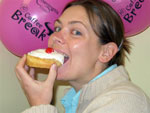 Nicola Davies
Nicola Davies
Media & PR Manager, Gloucestershire County Council
Height: 5ft 4
Weight 11 stone
Currently still breastfeeding (twice a day)
Monday
6.30am – 1 pint of water
8.45am – Two slices of wholemeal toast with margarine, 1 coffee
12.45pm – 1 packet of salt & vinegar squares (rushing home to get baby)
2.30pm – 2 slices of brown toast with butter, 1 pint of water
4.45pm – 1 cup of tea (with whole milk) and 1 banana
7 ish – 1 pint of water
8.30pm – Chicken, onions, mushrooms, peppers omelette (4 egg)
9 -10.30pm – 1 glass of red wine, half pint of beer, 2 pints of water before bed.
Tuesday
6.30am – 1 pint of water
8.45am – 1 large latte (with a shot of hazelnut syrup) and two biscotti
1.30pm – Mixed salad (beans, carrot, tomatoes, cous cous, veg). 1 strawberry.
3.20pm – 2 small glasses of water
8.00pm – Bangers and Mash (1 old spot pork sausage, 1 pork & black pudding sausage, gravy, broccoli, cauliflower, mashed potato made with butter and milk)
8.30pm – 2 pints of water before bed
Wednesday
6.30am – 1 pint of water
9.00am – 1 cup of tea
9.30 – 11.00am – 4 malted milk biscuits
12.00 noon – Bowl of fruit salad – mixed fruit.
12.30pm – 1 pint of sparkling mineral water. Buffet of Indian and thai food – including rice, noodles, curry, onion bhaji, poppadums, prawn crackers.
3.00pm – Mug of hot water
7.30pm – Half a rump steak and salad, 2 pints of water
Rob says…
Another diary member who skips breakfast. To miss breakfast is real folly – especially as it seems you have a family to look after and we all know the pressures that has on our energy levels. Combine that with a working day and it becomes even more important to eat well. You must start the day with a good breakfast otherwise the feeling of need to graze on something high in energy becomes common place and a hard habit to break. Also it is just as quick to eat some grapes, blueberries or a banana when rushing to get baby as it is a packet of crisps!
To change to skimmed milk or semi skimmed milk is not a difficult thing to do. Although I am guessing your baby is under two years of age so is on whole fat milk at present and it saves you buying two different types. Once a baby reaches two you can move to semi skimmed milk.
Otherwise not a bad diary. I think as a team you could all work together on a recipe and top tip exchange scheme. You are all doing very well but one or two could do with the team support to move to a perfectly balanced diet.
Liz Says…
This diet is quite scant and doesn’t look like it can be providing you with much energy. Most of the food is eaten in the evening, which means that you’ve got to go all day before you get a decent meal. It would be better to try and spread things out more over the course of the day, and try to eat a bigger breakfast. Having toast for breakfast and lunch is not going to provide you with a balanced diet, though I appreciate it’s difficult to look after your own diet while looking after a baby! It may be a coincidence, but the three evening meals you had all contained foods which are high in cholesterol, e.g. eggs, black pudding, Indian food. Although high blood cholesterol levels are not due to the amount of cholesterol consumed in the diet, people who do suffer from this condition need to be careful about how much cholesterol they eat.

Lisa Bonnell
Media & PR Officer, Gloucestershire County Council
I’ve recently decided that it’s about time I decided to get healthy and shed a few pounds (or stones!)
Since March 1, I have been ‘on a diet’, which involves me eating as little fat as possible, which has resulted in extreme cravings for fruit!
Height: 5ft 6” Weight: I’m not saying yet!
Monday March 16 – Day 15 of ‘the diet’.
8:45am: Special K cereal and semi-skimmed milk
11.15am: Glass of water
2pm: Plain chicken sandwich on white bread
6.30pm: 500g of white and black grapes, four slices of honey roast ham, unsweetened fruit juice (Felt ill all day so not very hungry for a change!)
Tuesday March 17
9.15am: Glass of unsweetened fruit juice, two bananas
11.45am: One ham sandwich on granary bread
1pm: Glass of unsweetened fruit juice, four strawberries
2pm: Packet of sour cream and chive Snack a Jacks (feeling peckish again!)
3.20pm: Banana and glass of unsweetened fruit juice
6.30pm: Pint of orange and mango squash
8pm: Chicken, red pepper and onion tortilla with baked garlic and herb potato wedges
8:45pm: Half a Cadburys Flake bar
9pm: 45mins boxing on the Wii
Wednesday March 18
9am: Banana, 100g of green and black grapes and glass of unsweetened fruit juice
1pm: Pint of orange squash, chicken tikka pieces, two triangles of naan bread, red thai curry, egg fried rice and an onion bhaji. (morale boosting lunch with Media Team)
3pm: Handful of grapes
4pm: Glass of water
5:40pm: Banana
One mile walk
8pm: Red salmon sandwich on granary bread
8:30pm: 45mins boxing on the Wii
Rob says…
Uhm – this is an interesting one. Diet – what’s the point? It is always going to be about the ‘energy eat’ meeting your ‘energy out’ and a balanced diet. For guidance on eating a balanced diet, check out the Food Standards Agency Eatwell plate online…details at the beginning of this post
It is important for you to consume some red meat for your body to be able to fight off free radicals. What you are eating here is without doubt healthy but there are some vitals that are missing such as the red meat, pulses, seeds and you are eating very few vegetables. Quite a lot of your good work is undone by you eating crisps that will fill you with a quick hit energy burst and very little else.
If I were you I would graze regularly on the fruits that you list such as grapes, raisins, Satsuma and focus on having a great breakfast, light lunch and a good wholesome main meal in the evening.
Liz says…
You must be constantly starving on this diet, particularly as you are combining it with exercise! Choosing to cut some fat out of your diet is a good thing but your body does need some ‘good’ fats, so oily fish, seeds, nuts and olive oil would be good things to introduce. Swap the Special K for some good muesli which will fill you up much more. You need to eat a certain number of calories every day to keep your energy levels up, if you eat a drastically reduced diet, your body can adjust its metabolic rate downwards (otherwise known as starvation mode) and will attempt to hang on to any excess weight you have for emergencies, i.e. you won’t lose any weight.
You’re drinking a lot of fruit juice. Although this may not contain added sugar, fruit naturally contains sugars so your diet is actually quite high in sugar. This sugar will give you short bursts of energy by boosting your blood sugar levels temporarily but you need to eat more complex carbohydrates which will give a sustained energy release and stop you feeling hungry. These include pasta, oats, potatoes and rice. Good luck with the weight loss.
 Steve Kitchen
Steve Kitchen
BBC Radio Gloucestershire
Presenter of The Lunchtime Show and Matchday
Lives: Born and bred in Cheltenham
Build: Very overweight so trying to do my bit – every now and then.
Diet: Fussy? No I prefer – “owner of a sensitive palate”, so amongst others on the NO list are chillies (anything spicy), onions, peppers, milk, tomatoes, eggs, anything too greasy, tea and coffee. I am also in the throes of giving up chocolate for Lent – it’s not doing me any harm.
Monday
8.45am – Glass of water & piece of white toast with light margarine as I walked out of the door.
10.30am – As I’m on air over lunchtime so I start hitting my lunchbox to graze at my desk as I get the show ready. First out of the box, 3 salt and vinegar rice cakes, much to disgust of my colleagues in the newsroom as apparently they smell like glue.
11.00am – Pure orange juice & 2 wholegrain rolls filled with chicken and lettuce.
12-3pm – The Lunchtime Show, so 3 hours of swigs from 2 small bottles of water.
3.30pm – Feeling hungry now so back into the lunchbox for 1 banana, a few red grapes, a Special K cereal bar & can of Diet Coke.
7.00pm – This is a different evening than normal as I’m co-hosting a Gloucester Rugby evening at Kingdom. Unlike broadcasting, there are around 100 pairs of eyes watching me, so believe it or not I’m a bit nervous. Despite wanting something stiffer I settled for a Diet Coke from the bar. I thought about ducking out of the food, but there’s a strong smell of Gloucester Sausage casserole in the air. I ate the sausage and potatoes but the casserole was littered with onions, so it was a case of thanks but no thanks.
10.45pm – After a really enjoyable and successful evening I arrived home with the munchies, so went for my favourite late night snack. A bowl of Special K cereal with berries (dry with no milk of course)
Tuesday (You might notice I’m a creature of habit!)
8.45am – Glass of water & piece of white toast with light margarine as I walked out of the door.
10.30am – 3 salt and vinegar rice cakes, once again to the chorus of “they stink!”.
11.00am – Pure orange juice & 2 wholegrain rolls filled with chicken and lettuce.
12-3pm – The Lunchtime Show so back to my 2 bottles of water.
3.30pm – Feeling hungry it was back into the lunchbox for 1 banana, a satsuma, a can of Diet Coke.
6.15pm – Teatime – cod in breadcrumbs (sorry Rob – frozen and out of a packet), jacket potato and soya beans (fast becoming my favourite veg – lovely with a sprinkling of salt).
10.30pm – Diet Coke and glasses of water through the evening and the return of the dry Special K.
Wednesday (Here we go again!)
8.45am – Glass of water & piece of white toast with light margarine as I walk out of the door.
10.30am – 3 salt and vinegar rice cakes – they might smell but they are pretty addictive.
11.00am – Pure orange juice & 2 wholegrain rolls filled with Wiltshire ham and low fat cheese.
12-3pm The Lunchtime Show so back to my 2 bottles of water.
3.30pm – Feeling hungry it was back into the lunchbox for 1 apple, a satsuma, and a glass of water.
6.15pm – Teatime. My wife is the chef of the house and she’s a lover of spicy food so quite often she does two meals. Tonight it was a chicken, kale, sugar snap peas in BBQ sauce (even this was a bit hot for me) with steamed rice.
8.30pm – After weeks of trying for different reasons, we made it to the cinema to see the brilliant Slumdog Millionaire, and shared a Diet Coke and sweet popcorn.
Right that’s me done, so it’s back to the greasy spoon for Full English Breakfast tomorrow. No only joking, I’d only eat the bacon and sausage, I don’t like the rest!!!
Rob says…
Steve has reasonably good dinners and the majority of his snacks also are quite good. I think it would be great if Steve can pack in some fresh fruit with his breakfast though – so that he is already getting a slow release of energy in time for his show. Great to see that he has some fish, frozen fish is often as nutritious as fresh and no doubt it was dry baked rather than fried which again provides a healthier option. The repetitiveness of Steve’s morning and lunchtime cycle needs to be broken though with a little more variety in there. It would be also good to consider some snacking during his show, difficult I can imagine but a few nibbles of some nuts or semi dried fruits may help.
Great to see you having some Kale as our grandmas use to say ‘the green vegetables are the ones that pack a real punch’, full of lots of iron and vitamins essential for the body to work well. I love it with some chopped garlic and sauté chillies. Water during the show is also brilliant, this is the best drink to keep you hydrated and such a pressured “live” show would certainly cause the nerves to jangle and the body to lose moisture! There isn’t too much dairy in Steve’s diary, it is important to consider the levels of saturated fats in our body but there is also a need to get calcium. Milk with cereal is so much better for you and the calcium will also help break down the fibre in the Special K making it even better to absorb the fortified goodness. Personally I don’t get the benefit of light margarine, go with butter and spread it thinner.
Liz says…
Steve is spreading his eating well over the course of the day. Eating small meals or snacks at regular intervals is much better than eating two or three large meals. His blood sugar levels should remain steady providing him with sustained energy release during the day and stopping him from being tempted to ‘pig out’. I’m not so sure about the white toast for breakfast though. White bread has a low glycaemic index meaning it is broken down and absorbed quickly into the bloodstream providing a short burst of energy which is not sustained. This breakfast is likely to leave him feeling hungry again within half an hour. Wholegrain bread or cereals, particularly oats, will provide a longer-lasting feeling of fullness.
Lots of fruit being eaten, but not many vegetables apart from soya beans. I get the impression Steve is not a big fan of vegetables judging by his reaction to the casserole! He should try to eat vegetables of different colours, it doesn’t have to be a lot of each one, he could experiment, there are so many different vegetables available these days. He could try sweet corn, red cabbage, broccoli, beetroot, butternut squash (delicious roasted in the oven with garlic and a little olive oil).
Filed under: Debate of the Month, Healthy Eating | Tagged: balanced diet, Cotswold Chef, diet, food debate, food labelling, Food Standards Agency, food tips, Get Gloucestershire Cooking, gloucester, Healthy Eating, Liz Moran, local food, New Years Resolutions, nutrition, Rob Rees, trading standards, VISION, Worcestershire Scientific Services | 1 Comment »






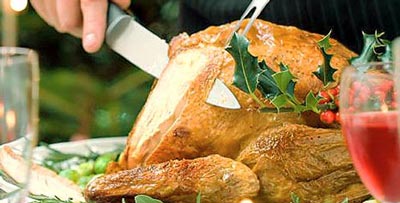
 How much do we really know and understand about the dates given on our foods that we buy from supermarkets, grocers, butchers and the like? Apparently not a lot if the high food poisoning figures for the population are looked at. Is this due to us not understanding the meaning of the dates or how to store foods or how long to keep them for?
How much do we really know and understand about the dates given on our foods that we buy from supermarkets, grocers, butchers and the like? Apparently not a lot if the high food poisoning figures for the population are looked at. Is this due to us not understanding the meaning of the dates or how to store foods or how long to keep them for?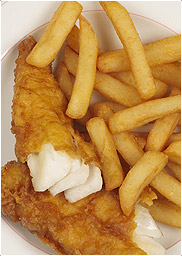 Fish and chips! One of the nation’s favourites, but some of us might be getting more than we bargained for when we order cod and chips!
Fish and chips! One of the nation’s favourites, but some of us might be getting more than we bargained for when we order cod and chips! See Rob Rees’s comments below on the food diaries of local celebs and members of our media team.
See Rob Rees’s comments below on the food diaries of local celebs and members of our media team.

 Celeb No. 2
Celeb No. 2
 Dawn Birtles
Dawn Birtles
 Jayne Bailey
Jayne Bailey Sarah Wood
Sarah Wood Nicola Davies
Nicola Davies
 Steve Kitchen
Steve Kitchen